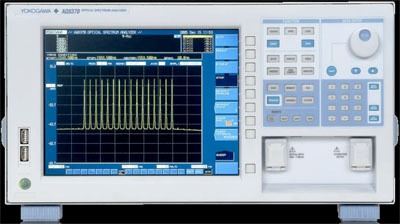
|
|
The Yokogawa AQ6370 Optical Spectrum Analyzer uses a double-pass monochromator structure to achieve high wavelength resolution (0.02 nm) and wide close-in dynamic range (70 dB). Thus, closely allocated signals and noise can be separately measured. OSNR measurement of 50 GHz spacing DWDM transmission systems and EDFA evaluation with multiple wavelength sources can successfully be performed. It is equipped with GP-IB, RS-232C, and Ethernet (10/100BASE) interfaces to be connected with an external PC for remote access and building an automated test system. The AQ6370 has a 128 MB user area in the internal memory that can save test setups, waveforms, analysis results, and macro program files. It is large enough to save more than five thousand traces. Specifications. Applicable fiber: SM (9.5/125 µm), GI (50/125 µm, 62.5/125 µm). Measurement wavelength range: 600 to 1700 nm. Wavelength accuracy: ±0.02 nm (1520 to 1580 nm). Wavelength linearity: ±0.01 nm (1520 to 1580 nm). Wavelength repeatability: ±0.005 nm (1 min.). Measurement data point: 101 to 50001. Wavelength resolution setting: 0.02, 0.05, 0.1, 0.2, 0.5, 1.0 and 2.0 nm. Resolution accuracy. ±5 % (1450 to 1620 nm, resolution setting: 0.1 to 2.0 nm,resolution correction: ON, measurement data point setting: AUTO). Level sensitivity: -90 dBm (1300 to 1620 nm, resolution: 0.05 nm or wider, sensitivity: HIGH3). Level accuracy: ±0.4 dB (1310/1550 nm, input level: -20 dBm, sensitivity: MID, HIGH1, HIGH2 and HIGH3). Level linearity: ±0.05 dB (Input level: -50 to +10 dBm, sensitivity: HIGH1, HIGH2 and HIGH3). Level flatness: ±0.1 dB (1520 to 1580 nm). Maximum input power: +20 dBm (Per channel, full span). Polarization dependency: ±0.05 dB (1550/1600 nm), ±0.08 dB (1310 nm). Display: 10.4-inch color LCD (Resolution: 800 x 600).
|